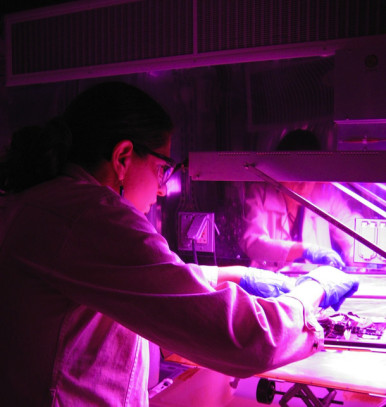U.S.A. Produce, -freshly grown in space,- may be the future. Aboard the International Space Station (ISS), scientists have had a breakthrough. The project Veg-01, located in the Veggie facility on the ISS, and has successfully yielded plants like lettuce and radishes grown on “plant pillows”. Having a fresh source of food in space could revolutionize the future of space travel and research, and may have implications for agriculture as a whole.
ROOSTERGNN had the opportunity to speak with Dr. Gioia Massa, a project scientist at Kennedy Space Center and the science team lead for the Veggie hardware verification test.
The plant pillows on Veggie may help astronauts prolong mission times, which would be great. What other benefits might they have?
The plant pillow concept is very versatile – we can customize pillows with different types of media and fertilizer, and pillows are modular and can be different sizes for different types of plants. After we establish the functionality of the Veggie hardware and the safety of crops grown using it, we might send extra plant pillows to ISS. In between experiments the crew might grow a variety of plant types if pre-planted pillows are available. Since the pillows contain dry seeds, many of these can be stored for long durations and will remain viable.
How exactly could they help humans on Earth? Will we begin cultivating plants in space one day?
We are learning lessons about nutrient use, watering, and plant microbial populations in closed environments from the Veggie system. Many of these lessons will also apply to Earth-based agriculture in controlled environments. We have been cultivating plants in space for a while, but the longer a mission off Earth, the greater role that plants might play, as a food source, as a method to regenerate the atmosphere, and as something that will be psychologically beneficial. Plant growth can mark the passage of time, add colors, textures and odors to an otherwise uniform environment, and gardening might act as a stress relief for the crew.
How do you overcome obstacles related to zero gravity with the Veg-01 plant pillows?
The plant pillows are essentially space “grow-bags” which contain the growth media, fertilizer, water and plant roots. The pillow serves as an incubator for the seed, allowing it to germinate, and then it serves as a way to anchor and water the plant as it grows. We use elastic bands to anchor the pillows to the water reservoir. Since having debris or water floating free in microgravity is undesirable, containment of these is the primary function of a pillow.
Which plants will most likely be cultivated aboard space stations in the future? Why?
In the near term we believe plants that can be eaten without processing or cooking (salad-type plants) will be grown. These include leafy greens, tomatoes, peppers, strawberries, radishes, herbs, and similar types of crops. This is because the astronauts really have no way to cook on the ISS. For longer duration missions, like a Mars habitat, there will likely be cooking facilities, so crops like potato and sweet potato, which require minimal cooking, may be grown. Crops like wheat and soybean which require extensive processing before being eaten will likely not be grown for food for a while. Equipment to process these is heavy and launching heavy things is expensive!
Are the vegetables safe to eat? What are some potential issues?
One of the things we are testing is food safety. Right now we don’t know how safe the produce is. There are a number of microorganisms that might be on the ISS, and the potential exists that these could be on the plants and could be harmful. We think it is unlikely, but we have to check. Currently there is no way to clean or wash vegetables on the space station. We are also working on figuring out what would be needed to develop these techniques.
How energy efficient are these pillows?
The Veggie hardware is a new design, with the only energy used to power the LED lights and the fans that drive air movement. Unlike previous growth systems the watering component of the Veggie–the reservoir and the plant pillows–is entirely passive and uses no external power. We do use crew time, however, because an astronaut has to fill the reservoir with water periodically. We are testing to see how well this growing system works.
***
Dr. Gioia Massa is a project scientist at Kennedy Space Center and the science team lead for the Veggie hardware verification test. She holds a Ph.D in plant biology and has done postdoctoral work in the areas of food production and bioregenerative life support. She has been interested in growing plants in space since her first agriculture class at age 12.

